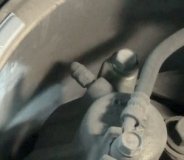Open the hood and locate the brake master cylinder. It is usually located on the driver side of the firewall, near the top. It will have a reservoir, where brake fluid can be added, and it will have several steel tubes (brake lines) that are connected to it with threaded fittings. If there are two similar assemblies, the larger one will most likely be the brake master cylinder. Check the brake fluid level, and add fluid if necessary.
Using a flashlight, inspect the fittings, tubes and reservoir for any leaks. If leaks are visible, they must be repaired and the system must be bled before going further. Also inspect where the master cylinder mounts to the brake booster, if equipped, which is a large flat canister-shaped assembly behind the master cylinder. If there is any leakage at the rear of the master cylinder, it is probably defective and must be rebuilt or replaced.
Get into the car and sit behind the wheel. Do not start the engine. Press firmly on the brake pedal and maintain this pressure with your foot. Hold the pedal down with even, steady pressure for about 15 to 20 seconds, and note if the pedal drops. Release the pedal, start the engine, and repeat this test with the engine running. If the pedal height remains consistent during both tests, your brake master cylinder is probably working properly.
If your brake pedal drops, inspect the brake system for leaks. Trace and inspect the brake lines. Use a floor jack to raise the car, and support the frame with jack stands. Remove the wheels with a lug wrench, and inspect the inside of the wheels and the brake assemblies for signs of leakage.
If any leaks are found, repair or replace the leaking components, bleed the brake system, and repeat Step 3.
If no signs of leakage are found, try bleeding the brake system. If bleeding the system does not correct the problem, your brake master cylinder is most likely defective.
Wednesday, May 19th, 2010 AT 12:05 AM


